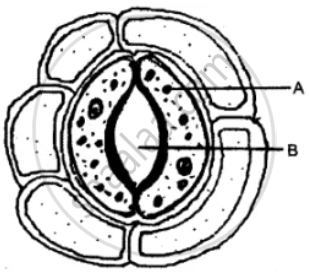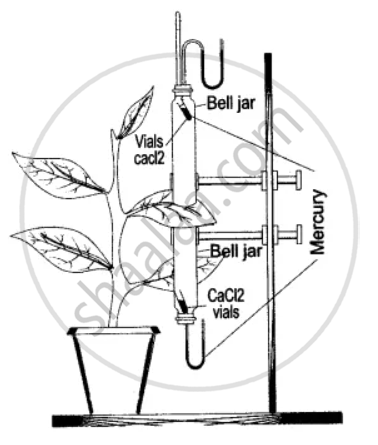Advertisements
Advertisements
Question
The diagram below represents a structure found in a leaf.

Study the same and answer the questions that follow:
(i) Name the pis labeled A and B.
(ii) What is the biological term for the above structure?
(iii) What is the function of the part labeled A?
(iv) Mention two structural features of A, which help in the function mentioned in (iii) above.
(v) Where is this structure likely to be found in a leaf?
(vi) The above structure helps in the process of transpiration. Explain the term transpiration.
(vii) How many other cells are found surrounding this structure as seen in the diagram?
Solution
(1) A—Guard cell B—Stoma.
(ii) Stomatal apparatus.
(iii) Regulates opening & dosing of Stomata.
(iv) It gives rigidity and protection to the cell.
(v) On the epidermis of the leaf.
(vi) Transpiration is the loss of water as water vapours from the aerial parts of the plant.
(vii) Five.
APPEARS IN
RELATED QUESTIONS
How do stomata differ from a lenticel?
Explain the Term
Stomatal transpiration
Differentiate Between Cobalt chloride paper and Goat’s bladder.
The apparatus shown here is Girreau’s poto-meter designed to demonstrate unequal transpiration from the two surfaces of a dorsiventral leaf. Before keeping the leaf in between the cups, anhydrous calcium chloride (CaCl2) contained in two small vials were weighed and placed in both the cups. The ends of the cups were closed with corks through which two mercury manometers were connected. After a few hours, CaCl2 vials were taken out and weighed again.
(i) What is the purpose of keeping CaCl2 vials inside the cup?
(ii) After a few hours, the CaCl2 vials were taken out and weighed again. Will you expect any difference in weight? If so, give reasons.
(iii) What was the purpose of using a mano-meter?
(iv) What do you mean by transpiration?
Given below is an apparatus used to study a particular process in plants. Study the same and answer the questions that follow :

(i) Name the apparatus.
(ii) Mention one limitation of this apparatus.
(iii) Which phenomenon is studied with the help of this apparatus?
(iv) What is the function of the part marked ‘reservoir’?
(v) What is the role of the air bubble in the experiment?
Name the three kinds of transpiration.
Give a reason/suitable explanation.
More transpiration occurs from the under surface of a dicot leaf.
